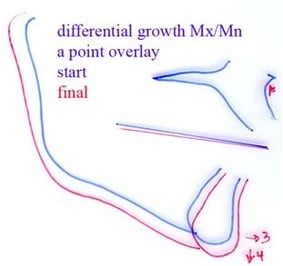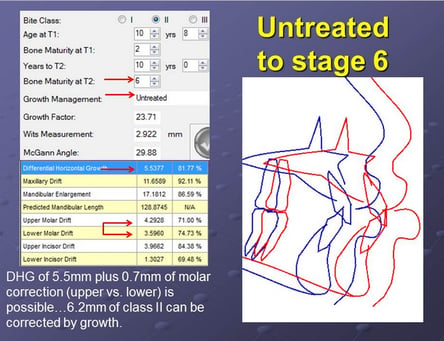How one dentist created unprecedented growth predictions from the most statistically significant growth study in dental history
In the past decade, there has been a large increase in our knowledge of dentofacial growth. The exciting advances are allowing dentists to have unprecedented knowledge of their growing patients. Dentists now have data on the expected maxilla and mandible growth left for an individual patient. These new tools can help dentists to decide when and how to start treatment for the greatest chance of success.
The Achilles tendon of orthodontics
Growth management has been as Dr. David Dana says “the Achilles tendon for all of us that do ortho.” He admits that there is an unspoken flaw in the specialty. “We talk about growth…but it’s been a lot of trial and error.” For decades, dentists and orthodontists from all types of philosophies and backgrounds have had frustrations stemming from the unpredictability of growing patients.
Growth is a powerful tool, especially within orthodontics. It could help a patient’s treatment or severely hurt it. For example, if you start orthodontic treatment of a Class III patient too soon in their growth stage, you may get relapse back to Class III. (Read more on Class III growth or watch common issues treating growing patients.)
A study of 686 growing patients
In 2006 a Las Vegas dentist, Dr. Benson Donald McGann, started the largest growth study ever created in dentistry. In his past 30 years, he had diagnosed and/or treated tens of thousands of patients. But he felt like growth was the factor that made his case successful…or not...and he wanted to know how it would work on every growing patient he’d see. Understanding orthopaedic growth was a lifelong passion of his. He read literature from various researchers around the world like Wolfe, Araujo, Behrents, Buschang1, Grave, Townsend2, Ngan3, Mitchell, Jordan, Ricketts4, Burstone5, and much more, but the research on growth was lacking. Many of the studies were done on small sample sizes since it was extremely difficult to have hundreds of participants in any type of orthodontic longitudinal study. 
Dr. McGann decided to create an extensive research project to fully understand how growth can be managed to more predictably fix bites. Over 6 years he studied 686 cases, traced 2,000+ cephs, created 10,000+ overlays by hand, and put together 200 formulas to predict growth.
This study includes the largest sample size with the most statistically significant data within dental and orthopaedic growth research. McGann’s study included a sample size of 249 untreated cases from the Burlington Growth Centre6 at the University of Toronto’s Orthodontic Department, and 437 treated cases (without orthopaedic appliances) from his private practice, colleagues’ practices, and Bolton Brush’s sample at the Case Western’s Orthodontic Department.
We can now predict the growth of an individual
With the help of Ohio dentist, Dr. Shockley Wier, and statistics company The Taylor Collaboration, Dr. McGann was able to obtain and analyze the large amount of data. They determined key predictors of growth. He found that the horizontal growth of jaws (specifically, Differential Horizontal Growth, DHG) is a key factor to consider when treatment planning growing patients. He also discovered other key indicators like the McGann Angle, which is statistically highly significant at P=0.002, making predictions very effective for all case types.
Because of the large sample of this study, dentists can now predict a patient’s future growth based on gender, class, age, and race. With hundreds of prediction formulations, Dr. McGann decided to put his data into a software so that all dentists could predict growth successfully. Unlike many of the previous growth studies, the data is easy to understand and use. Dentists who use Dr. McGann’s Growth Prediction Software are able to better plan their growing cases with just 5 minutes of analysis. This is the first and only software that helps dentists predict future growth on an individual basis.

How dentists are now learning to use growth
The extensive new orthopaedic growth knowledge has been added to several orthodontic curricula. We at Progressive Orthodontic Seminars along with the McGann Postgraduate School of Dentistry, have incorporated Dr. McGann's work in our teachings. The following programs are listed in increasing levels of training of growth from recent studies.
- Orthdontics for Children Series: Students learn the foundations of orthopaedic growth and when to start Phase I orthodontics for children with different malocclusions.
- Comprehensive Orthodontic Series: Students learn how to plan full orthodontic treatment for growing patients using growth adjusted VTOs based on class, sex and age.
- Dentofacial Orthdontics Series: Students learn how to use an additional tool, the Growth Management Software, which provides even more accurate predictions for individual patients.
With this new growth knowledge, dentists are seeing far better orthodontic retention and treatment times with kids and teenagers.
References
- Wolfe SM, Araujo E, Behrents RG, Buschang PH. Craniofacial growth of Class III subjects six to sixteen years of age. Angle Orthodontist. 2011; Vol 81 No 2.
- Grave K, and Townsend G. Hand-wrist and cervical vertebral maturation indicators: How can these events be used to time class II treatments? Australian Ortho Journal. November 2003; 19:33-45.
- Ngan P. Early treatment of Class III malocclusion: Is it worth the burden? American Journal of Orthodontics and Dentofacial Orthopedics. 2006: Vol 129, No 4, Supplement 1.
- Mitchell D, Jordan JF, Ricketts RM. Arcial growth with metallic implants in mandibular growth prediction. Emory University School of Dentistry. American Journal of Orthodontics. December 1975: Vol 68, No 6, p655-659.
- Burstone C. Process of maturation and growth prediction. American Journal of Orthodontics. 1963: Vol 49, No 12, p907-919.
- Thompson GW, Popovich F. A longitudinal evaluation of the Burlington Growth Centre Data.

